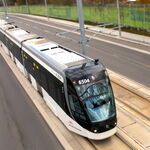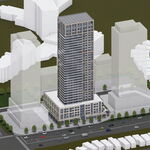Why don't we focus (for now) on Toronto-Kingston rather than Kingston-Smith Falls?
[Edit: Re-uploaded correct Table 1 and Table 3, which had disappeared during one of the previous edits]
Toronto-Ottawa-Montreal definitely has enough demand, but even then, I would first like to beef up the existing service. It's ridiculous that we only have 1 express train to Ottawa and Montreal per day. We should have hourly service, much like the flight schedules, and add a lot more express. Also if VIA could get funding to upgrade this main line, the trip can shave off 30-45mins and make it competitive for downtown to downtown travel with flying even from Porter.
The problem is that to first beef up the service between Toronto and Ottawa, we'd need to invest even more heavily in the existing tracks than we already have. If the eventual goal is HSR, we might as well use new dedicated tracks to ease bottlenecks, rather than spending billions on capacity that will become wasted once we switch to HSR. Unlike west of Toronto, the bulk of travel in the Toronto-Ottawa-Montreal corridor is actually between those 3 cities.
My suggestion would be to start with a dedicated HSR line from Kingston to Ottawa, built to 300 km/h standards. It would be limited to 200 km/h (or 177 km/h with current equipment) until we electrify the whole line, but would still provide significant time savings on the Toronto-Ottawa trip. […]
The California HSR project is using a similar implementation strategy. They are building a 209 km segment between Fresno and Bakersfield to 320 km/h standards, and it will be used by the existing Amtrak trains at 177 km/h until the full route is complete. But even under diesel operation, the line would apparently save 45-60 minutes of travel time.
That's actually a very good idea. Most of the Kingston-Ottawa route is only single track (after it diverges from the mainline at Brockville) with a few passing sidings which significantly limits the reliability and frequency potential of the track. There's also the massive slowdown at Smiths Falls that adds almost 10-20 minutes to the trip (trains crawl at practically walking speed through that town--like Guelph).
My proposed initial line would be from Kingston to where the lines cross east of Smiths Falls (The train slowed to 85 mph there). The line to the east is the bypass south of Ottawa, which would be the final segment built.
I think that that alignment above from Kingston to Smiths Falls should be built to HSR standards, but be built ASAP in order to improve travel times now. Ditto for the mainline from Smiths Falls linking back up to the current line on the west side of Montreal. It could make a pretty significant difference now, and if it's built to be HSR ready, that's less trackage that you need to upgrade when it comes time to actually implement HSR.
I sometimes have the feeling that we keep forgetting the chronology of how HSR was built in Europe or Asia: In virtually all HSR nations, passenger rail had already achieved a significant modal share and the main reason for considering HSR infrastructure was less to reduce travel times than to ease the capacity constraints on the existing infrastructure: It was only after the need for additional tracks dedicated to the faster trains was established that the governments and their railway companies started to regard the alignment as variable. This is when they said “if we have to build new tracks anyways, we should build them so that we can reduce travel time as much as possible and thus decrease operational costs (on-board staff is paid per hour) and increase revenues (people are willing to pay and travel more if travel times decrease)”. The same reasoning applies when Japan considers building the worlds’ first inter-city Maglev service: Because the capacity of the existing Tōkaidō line has been reached with an annual ridership of around 150 million and despite 16 car-sets which accommodate up to 1,323 passengers each and run
up to 13 times an hour: Again, the existing infrastructure has become too constrained (on capacity rather than speed) that JR Central is considering its options and building a new Maglev line (Chūō Shinkansen) seems to be more practical and desirable (i.e. economically viable) than simply enlarging the existing viaducts and tunnels.
This means that in order to maintain any chance of seeing HSR in Canada within our lifetime, we should intensify the upgrades of the existing infrastructure until we finally reach the point where we are only left with those bottlenecks where it becomes more cost-efficient to build a new HSR line than upgrading and adjusting the existing alignments. You observed well that the only way to economically build HSR is to merge the Toronto-Ottawa-Montreal (
TOM) and the more direct Toronto-Cornwall-Montreal (
TCM) services, but cutting 35 minutes between Fallowfield and Kingston (as estimated by reaperexpress) will not be sufficient to offset the time penalty from going via Ottawa (TOM) rather than Cornwall (TCM) which is currently exactly one hour (107+109-156=60 minutes):
Minimum scheduled travel time Montreal-Ottawa: 1:47 h
Minimum scheduled travel time Ottawa-Kingston: 1:49 h
Minimum scheduled travel time Montreal-Kingston: 2:36 h
As indicated by the Map above, I believe that the priorities for speeding up (and eventually merging) VIA Rail’s TOM and TCM services should be as follows:
- Upgrading segments which are (a) used by both, TOM and TCM, (b) can be mostly upgraded to speeds of 160 km/h and more and (c) won’t eventually get bypassed by HSR segments (Top priority): Toronto-Gananoque (exact segments to be identified later) and Dorion-Montreal
- Upgrading segments which are (a) only used by either TOM or TCM, (b) can be mostly upgraded to speeds of 160 km/h and more and (c) won’t eventually get bypassed by HSR segments (Second-highest priority): Smith Falls-Ottawa-Moose Creek
- Construction of dedicated HSR lines to bypass segments currently used by both, TOM and TCM, where the alignment prevents an upgrade to speeds of 160 km/h and higher (Medium priority): Toronto-Gananoque (exact segments to be identified later) and (though rather theoretically) Dorion-Montreal
- Construction of dedicated HSR lines to bypass segments currently to be used initially by either TOM or TCM and eventually by both, where the alignment prevents an upgrade to speeds of 160 km/h and higher (Second-lowest priority): Gananoque-Smith Falls and Moose Creek-Monkland
- Upgrading of existing ROW which will in the future be used by both, TOM and TCM services (lowest priority): Monkland-Dorion
- Upgrading of ROW which will no longer be used once all dedicated HSR lines have been constructed (no priority): Gananoque-Brockville-Coteau-Dorion, Brockville-Smith Falls and Moose Creek-Coteau
As you can see above, Gananoque-Smith Falls has to me only
Second-lowest priority, which I would only pursue once the travel times on Toronto-Gananoque and Dorion-Montreal cannot be optimized further. Given the short length (40km) and heavily urban character of Dorion-Montreal, I would primarily focus on Toronto-Gananoque and start by approximating the minimum travel time of the current alignment:
As you are all contributing also in the discussion on the
High Speed Rail: London - Kitchener-Waterloo - Pearson Airport - Toronto thread, I assume that you are already familiar with my travel time calculation tables, but based on the speed limits I assigned above, I calculate that the minimum travel time (Toronto-Gananoque with one intermediary stop in Kingston but none in Gananoque) achievable with the current alignment would be 2:19 hours – or even 2:13 (or 2:11) hours if someone acquires equipment capable of maximum speeds at 200 (or even 240 km/h).
However, in order to determine how these ideal travel times compare to what is apparently already possible with the current state of the infrastructure, we need to analyse VIA’s current travel times (assuming three typical train stop patterns and always taking the shortest available travel time between any subsequent stops):
I know these is an awful lot of number, but the conclusions I would draw are:
- Cell G5 suggests that the infrastructure has already been upgraded considerably and to a point where I would estimate that further infrastructure upgrades may only yield an additional 3 minutes for a non-stop Toronto-Kingston service (e.g. train 42)
- Cells G10 and G20 suggest that multi-stop trains could be sped up by 5-12 minutes (depending on the number of stops) if existing rolling stock would be replaced through train sets with modern acceleration and deceleration capabilities
- Cells H14/I14 and H19/I19 suggest that the least potential for further savings may lie between the station pairs Oshawa&Port Hope and Napanee&Kingston (as the minimum scheduled travel times even beat my simulation)
- Cells H12/I12, H17/I17 and H20/I20 suggest that the biggest potential for further savings may lie between the station pairs Toronto&Guildwood, Trenton&Belleville and Kingston&Gananoque
This means that we have identified three potential candidates for further infrastructure upgrades under
Category 1 (“
Top priority”: Toronto-Guildwood, Trenton-Belleville and Kingston-Gananoque) and two potential candidates for a the construction of a new dedicated infrastructure under
Category 3 (“
Medium priority”: Oshawa-Port Hope and Napanee-Kingston). As for the
Category 1 candidates, Toronto-Guildwood would require an upgrade to 4 tracks in order to eliminate conflicts with GO, especially as Queens Park intends to increase their frequency to every 15 minutes, whereas some part of Kingston-Gananoque will eventually become redundant as the HSR line Kingston-Smith Falls would leave the main line presumably somewhere west of Kingston Mills, i.e. after only approximately a third of the distance. Infrastructure improvements should therefore start with Trenton-Belleville (a segment which is almost straight) and then continue with Toronto-Guildwood. As for the
Category 3 candidates, we should start looking for alternative alignments and it turns out that in both cases, the 401 allows an alignment which is significantly faster and shorter than the current CN alignment, where speeds are mostly restricted to speeds of 120 (and in the case of Napanee-Kingston: sometimes even 80 km/h):
The first HSR segment would be approximately 38 km long, leaving the CN alignment directly after Oshawa and rejoining just before Port Hope after following (and crossing two times) the 401 Freeway:
The second HSR segment would leave the CN alignment in Marysville and rejoin it approximately 57 km later in Kingston Mills after bypassing Napanee and Kingston, thus necessitating the construction of new rail stations on the northern side of the 401 Freeway:
With the two new HSR segments, I simulate the following travel times (again with one stop in Kingston, but none in Gananoque):
This means that the non-stop travel time from Toronto to Kingston could be reduced from currently 2:02 hours (train 42) to 1:49, 1:36, 1:31 and 1:29 hours for a maximum design speed of 160, 200, 240 and 320 km/h respectively.
Moreover, the following table compares the minimum travel time (from Toronto with no stop in Kingston or Gananoque) of the current alignment with what would be achievable with the new alignments:
Following this table, the new segments would allow additional travel time savings of approximately 15 minutes (of which one third originates from Oshawa-Port Hope and the remaining two thirds from Belleville-Gananoque). Furthermore, as design speed increases to 200, 240 or even 320 km/h, these travel time savings (originating from the new HSR segments as well as according improvements on the existing alignment as shown in Table 3) may increase to 29, 34 and 36 minutes respectively.
But what immediate effect would the construction of the two proposed HSR segments have on the travel times of current VIA services? As I’ve shown in Table 2, the travel times of VIA Rail’s faster services are already very close to the minimum feasible travel times I simulated for the current alignment, whereas those with frequent stops are significantly slower than the minimum travel times I simulated for these stop-patterns, indicating that VIA Rails’ equipment has rather poor acceleration and braking capabilities. However, if I assume that VIA Rail would acquire more modern locomotives, I estimate that the travel times (as calculated for these six typical VIA Rail services) would shrink by approximately 15 to 35 minutes (29 to 48 minutes if the design speed of the infrastructure can be raised to the LRC’s design speed of 200 km/h) between Toronto and Gananoque (whilst making the extremely conservative assumption that improved locomotive capabilities would not also affect travel times beyond Gananoque):

The point I try to make is that as with any public or private investment project, dedicated HSR infrastructure will be most viable where it yields the largest benefit relative to cost. Where you advocate to build an 80+ kilometer long HSR corridor through topographical difficult and (presumably) environmentally sensitive terrain which would only serve the Toronto-Ottawa-Montreal (TOM) services for years to come, I propose building 95 (37+58) kilometer of HSR lines on predominantly flat terrain and for the overwhelming majority of distance parallel to the 401 Freeway, whilst accommodating TOM and Toronto-Cornwall-Montreal (TCM) services from day one.
Unfortunately, the idea of building dedicated HSR infrastructure seems overly optimistic in the current political climate in Canada. Nevertheless, we, VIA Rail and anyone else interested in a more powerful Canadian passenger rail transport system can help by identifying those sectors which would free up travel time savings in the most cost-effective manner if they were bypassed and then focus the limited capital improvement funds available on the remaining (i.e. Priority 1 and 2) sectors until the governments in Ottawa and Toronto change their attitudes towards investing billions into dedicated HSR infrastructure.
The map below displays the existing railways (blue), an HSR line (red), and the low points in speed (in mph) I measured on my trip.
[…]Assuming that a 177 km/h cruising speed would increase this to 160 km/h (including slowing down to rejoin the existing railway), the segment would take 7 minutes.
My estimate for the whole initial segment (assuming an average speed of 172 km/h over the new HSL) is a travel time of 52 minutes from Fallowfield to Kingston, 35 min faster than I recorded on my trip.
At the time, the schedule was 3h 59 from Ottawa to Toronto, but now it is only 3h 48. Assuming that all the time saved is elsewhere along the route, this change would reduce the travel time from Toronto to Ottawa to 3h 23. In comparison, Google maps estimates that driving takes 4h 04 with no traffic.
If you want a less arbitrary estimation of the travel savings of your “initial segment”, post or send me the .kmz file you apparently created on Google Earth and I will compile for you tables similar to the tables of this post…

I think I need a beer now...
 Related posts:
Related posts:
High Speed Rail: London - Kitchener-Waterloo - Pearson Airport - Toronto Thread: V: Toronto-Kitchener-London vs Toronto-Burlington-London








